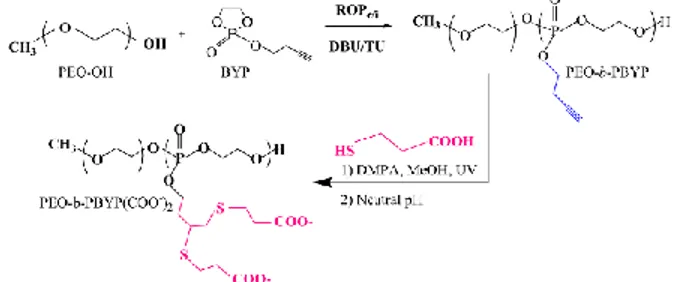SYNTHESIS OF DEGRADABLE POLYPHOSPHOESTER COPOLYMERS FOR TEMPLATING CALCIUM CARBONATE DRUG DELIVERY CARRIERS
Ergul Yilmaz Zeynep1, Debuigne Antoine 1, Calvignac Brice2, Boury Frank2, Jerome Christine1
1Center for Education and Research on Macromolecules (CERM), University of Liège (ULg),Chemistry Department Sart Tilman, Building B6a-third floor, Liège, B-4000, Belgium
2INSERM U1066, Micro et Nanomedécines Biomimétiques, IBS, University of Angers, 4 rue Larrey, Cedex 9, Angers, 49933, France
zeynep.ergul@ulg.ac.be
SUMMARY
Degradable acid bearing polyphosphoester (PPE) copolymers were prepared by combination of organocatalyzed ring opening polymerization and click chemistry. Their solution behavior and ability to complex calcium ions were studied as well as their capacity to template CaCO3 particles dedicated to drug delivery. INTRODUCTION
The design of drug delivery systems (DDS) often requires biodegradable and biocompatible materials that allow safe retention and controlled release of the drug. In this respect, CaCO3 particles are appropriate drug carriers that have excellent properties such as low density, high specific surface areas and porosity for drugs and proteins encapsulation.[1] Here, hyaluronic acid usually used for templating CaCO3 particles was substituted by a degradable synthetic copolymer based on PPE. The latter is a promising candidate due to its biocompatibility, biodegradability and the low toxicity of its degradation products such as phosphates. We also introduced acid functions on the PPE segment in order to enhance its calcium affinity and ability to tune the morphology of the CaCO3 particles.
EXPERIMENTAL METHODS
The butynyl phospholane (BYP) polymerization was initiated from poly(ethylene oxide) PEO-OH by organocatalyzed ring opening polymerization (ROP) [2] followed by UV catalyzed thiol-yne addition of 3-mercaptopropionoic acid onto the alkyne functions according to ref [3]. CaCO3 particles were then generated in the presence of the copolymer following a procedure inspired from [4].
RESULTS AND DISCUSSION
Well-defined PPE copolymers bearing pendant alkynyl groups, i.e. PEO-b-PBYP (Ð <1.1), were obtained by organocatalyzed ROP of BYP initiated at 0°C from PEO-OH (Scheme 1). The copolymer was then reacted under UV with 3-mercaptopropionoic acid in order to introduce carboxylic acid functions along the PPE backbone by thiol-yne reaction.[3] NMR analyses confirmed that full functionalization was reached after 2h. The high density of
acid moieties in PEO-b-PBYP(COO-)2 is supposed to facilitate the Ca2+ complexation.
SCHEME 1. Synthesis of acid containing PEO-b-PBYP. The solution behavior and self-assembly of PEO-b-PBYP(COO-)2 in water was investigated by DLS with and without Ca+2 at different pH. Finally, stoichiometric amounts of CaCl2 and Na2CO3 were mixed in water containing the PEO-b-PBYP(COO-)2 which strongly influences the size of the CaCO3 particles (~1.5 µm).
(Figure 1)
FIGURE 1. SEM image of CaCO3 particles templated by PEO-b-PBYP(COO-)2.
CONCLUSION
The acid-bearing PPE-based copolymers were successfully prepared and used as templating agents for the synthesis of CaCO3 particles.
ACKNOWLEDGEMENTS
This work is supported by Erasmus Mundus Doctoral School Nanofar from the European Community.
REFERENCES
1. T. Beuvier et al., J. Mater. Chem., 2011, 21, 9757. 2. B. Clément et al., Macromolecules, 2012, 45, 4476. 3. S. Zhang et al., J. Am. Chem. Soc., 2012, 134, 18467. 4. H. Colfen et al., 1998, 382, 582.
